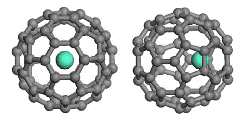Chemistry, Department of: Faculty Series

Xiao Cheng Zeng Publications
Document Type
Article
Date of this Version
3-1-2003
Abstract
Ab initio plane-wave total-energy calcuation is carried out to study the relative stability of the quasi-one-dimensional (Q1D) pentagon and hexagon ice nanotubes. Electronic structure calculations indicate the two Q1D ice nanotubes have nearly the same band structures and energy bandgap as those of proton-ordered bulk ice Ih . Ab initio molecular-orbital and density-functional theory calculations, as well as three classical potential models of water, are also employed to investigate the relative stability of the pentagon and hexagon water clusters (H2O) 30, (H2O) 60 , and (H2O) 120 . Clusters of this kind can serve to bridge the gap between the small polygonal water rings and the infinitely long Q1D polygon ice nanotubes. It is found that the polygon water prisms with the size (H2O) 120 begin to show the relative energetic behavior of the infinitely long polygon ice nanotubes.


Comments
Published by American Institute of Physics. J. Chem. Physics VOLUME 118, NUMBER 9, 1 MARCH 2003. ©2003 American Institute of Physics. Permission to use. http://jcp.aip.org/.